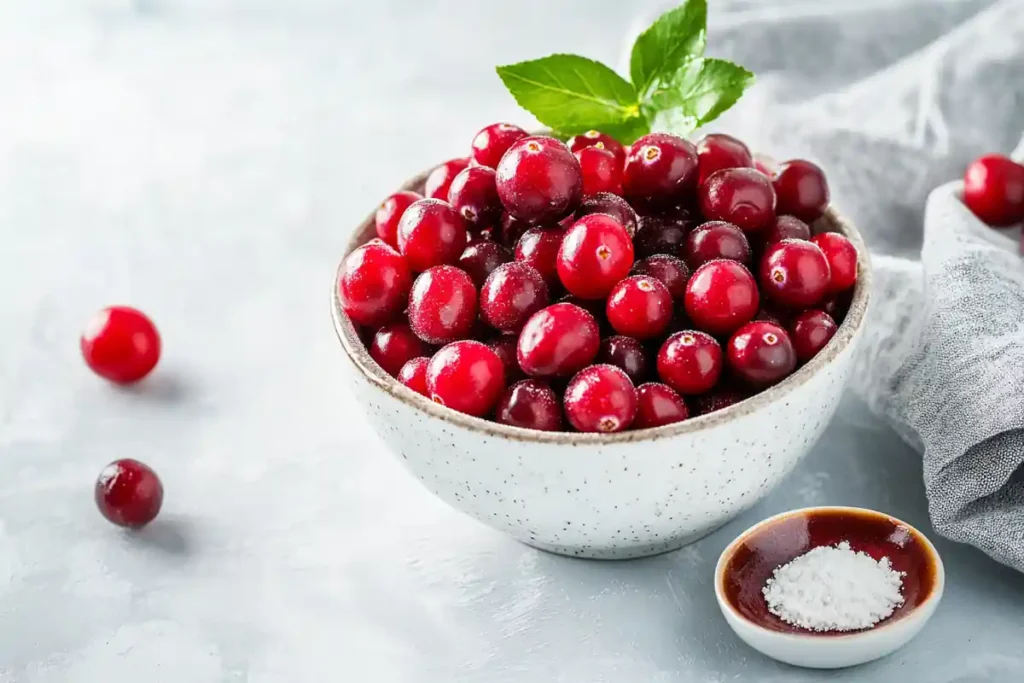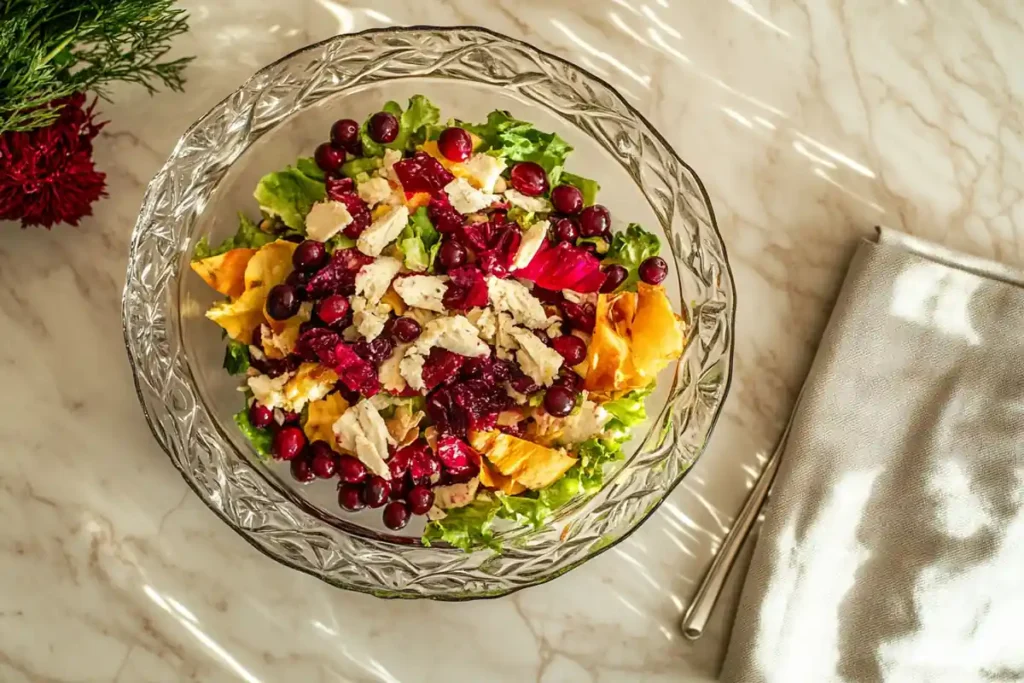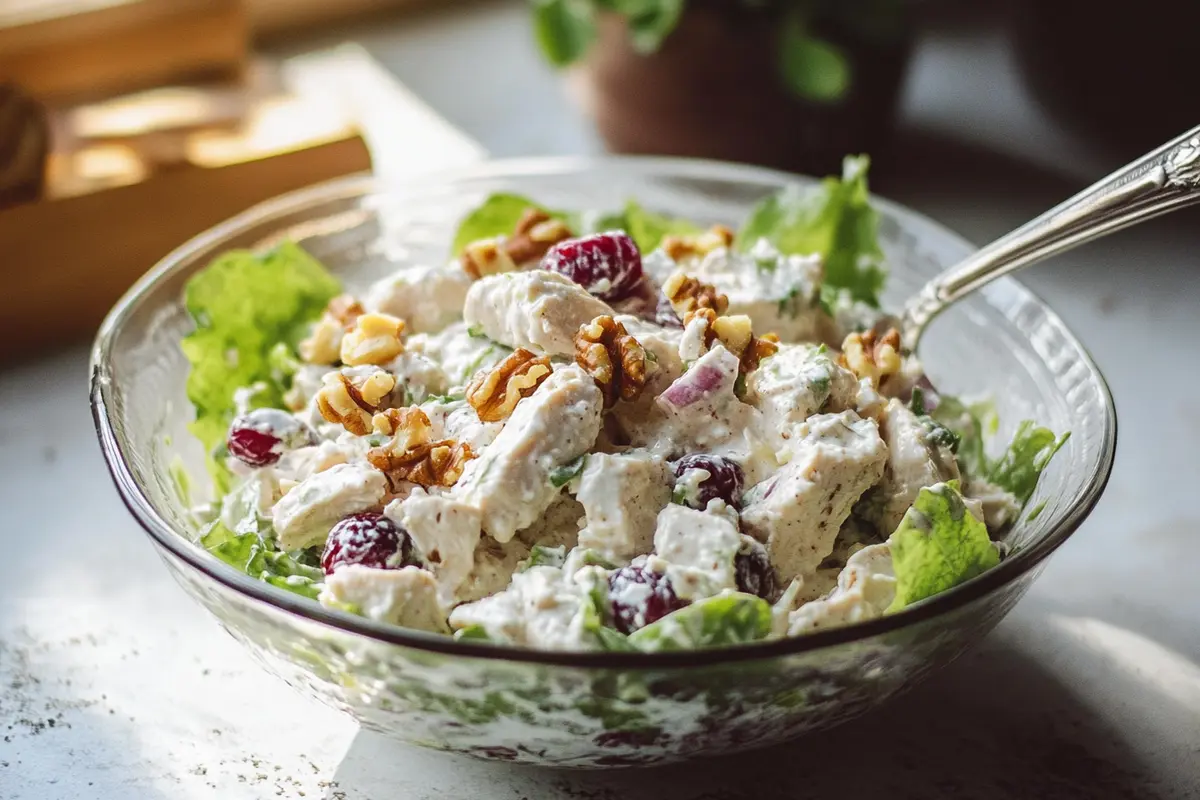introduction :
Why is my cranberry salad runny? This classic holiday favorite should be a firm, flavorful dish, but it’s frustrating when it turns into a watery mess instead. Whether you’re a seasoned cook or a beginner, small mistakes in ingredient choices or preparation can impact the texture. In this guide, we’ll uncover the main reasons cranberry salad becomes runny, common pitfalls to avoid, and expert tips to fix and prevent it. Plus, we’ll share the best techniques for achieving the perfect consistency every time. Let’s dive in!
Understanding the Issue

What Makes Cranberry Salad Runny?
Cranberry salad can turn out watery for several reasons, most of which boil down to ingredient ratios and preparation techniques. One of the culprits is the high water content in fruits like cranberries, oranges, and pineapples, which are popular ingredients in these recipes. When these fruits release their juices, they can overwhelm the dish.
Another factor is the type of thickening agent used—gelatin or other stabilizers. Without proper preparation or sufficient time to set, the salad may not firm up as expected. External factors like temperature and storage conditions can also play a significant role.
Differences Between Cranberry Salad and Cranberry Sauce
Although they might seem similar, cranberry salad and cranberry sauce differ significantly in texture and preparation. Cranberry sauce is often cooked down to create a thick, jam-like consistency, while cranberry salad typically includes fresh or frozen cranberries and relies on gelatin or whipped cream for structure.
Cranberry salad’s reliance on fresh ingredients and minimal cooking means it’s more prone to becoming watery. On the other hand, cranberry sauce has a thicker base due to the cooking process, which helps concentrate the mixture and prevent a runny texture.
Common Ingredients That Cause a Watery Consistency
Certain ingredients are more likely to make your cranberry salad runny. These include:
- Fresh fruits: Ingredients like pineapple and oranges naturally release juices over time.
- Liquid sweeteners: Syrups or honey can add too much moisture.
- Improperly prepared gelatin: Failing to dissolve or bloom gelatin properly can lead to a loose texture.
Understanding these ingredients’ effects will help you troubleshoot the issue and create a more consistent cranberry salad.
Key Mistakes That Lead to a Runny Cranberry Salad
Overusing Liquids: Juices and Syrups
One of the most common pitfalls when making cranberry salad is overloading it with liquids like fruit juices or syrups. While these ingredients add flavor, they also increase the moisture content, leading to a watery salad. When preparing your salad, aim to drain canned fruits thoroughly and limit additional liquids. A little goes a long way when it comes to achieving the perfect consistency.
Improper Gelatin or Thickening Agent Usage
Gelatin is often the backbone of cranberry salad, but using it incorrectly can spell disaster. For instance, if the gelatin isn’t fully dissolved, it won’t activate properly, leaving your salad too soft. Similarly, skipping the blooming process or using too much water during preparation can dilute its effectiveness. Follow package instructions carefully and use the right ratio of gelatin to liquid for a firm, jiggly texture.
Insufficient Cooling or Setting Time
Patience is key when it comes to cranberry salad. Cutting corners on cooling or setting time is a surefire way to end up with a runny mess. Make sure your salad chills for at least 4-6 hours—or even overnight—before serving. This ensures that the gelatin has enough time to firm up and stabilize the dish.
Not Accounting for High Water Content in Fruits
Fresh fruits like cranberries, pineapples, and oranges are delightful in salads, but they’re also packed with water. When these fruits release their juices, they can disrupt the balance of your dish. To prevent this, you can lightly blot or drain fresh fruits before mixing them in. Additionally, incorporating ingredients like whipped cream or nuts can help absorb excess moisture.
How to Fix Runny Cranberry Salad

Adding Cornstarch or Other Thickeners
If you’re wondering Why is my cranberry salad runny?, the quickest fix might be adding a thickening agent like cornstarch. Dissolve cornstarch in a small amount of cold water, then mix it into your salad. Heat gently to activate the thickener if necessary. Other alternatives include tapioca starch or arrowroot powder, both of which work well in cold recipes.
Increasing Cooling or Refrigeration Time
Sometimes, the simplest solution is also the best. If your salad is slightly runny, giving it more time in the fridge can work wonders. This allows the gelatin to fully set and any extra moisture to be absorbed. Remember, good things come to those who wait!
Balancing Liquids and Solids in the Recipe
An unbalanced ratio of liquids to solids is a frequent culprit for runny cranberry salads. To fix this, consider adding more solid ingredients like diced fruits, nuts, or marshmallows. These additions not only thicken the salad but also enhance its flavor and texture.
Tips for Fixing Salad After Preparation
If you’ve already served your cranberry salad and it’s too runny, don’t panic. You can quickly transform it into a different dish. For example:
- Serve it as a topping: Use the runny mixture over ice cream or pound cake.
- Blend it into a smoothie: Combine the salad with yogurt and ice for a refreshing drink.
- Freeze it into popsicles: Pour the mixture into molds for a unique frozen treat.
These fixes ensure that no part of your cranberry salad goes to waste, even if it didn’t turn out as planned.
Preventing a Watery Cranberry Salad
Choosing the Right Ingredients
To prevent a runny cranberry salad, start by picking the right ingredients. Avoid canned fruits packed in syrup and opt for fresh or frozen cranberries instead. If you must use canned fruits, drain them thoroughly to reduce extra liquid. Using whipped cream or marshmallows can also help absorb some moisture, creating a firmer texture.
Proper Measurements for Liquid Additions
Measuring ingredients accurately is essential to keep your cranberry salad from becoming too watery. Overpouring liquids, such as fruit juices or water, can upset the balance. Stick to recipe instructions and measure carefully to ensure everything blends together perfectly.
Best Practices for Using Gelatin
Gelatin is a game-changer when it comes to cranberry salads, but only when used correctly. To maximize its thickening power:
- Bloom it first: Let the gelatin soak in cold water for a few minutes before dissolving it in hot liquid.
- Mix thoroughly: Stir the mixture well to avoid lumps.
- Cool gradually: Let the gelatin mixture cool slightly before combining it with other ingredients.
Following these steps will give your salad the structure it needs to stay firm.
Setting Time: Why It Matters
A key step in preventing a watery salad is giving it enough time to set. Once you’ve prepared the salad, refrigerate it for at least 4-6 hours or overnight. Rushing this process will leave you with a loose, runny texture. Be patient, and let the magic happen in the fridge!
For more delicious recipes and tips, check out our Cranberry Walnut Chicken Salad guide for inspiration!
Popular Cranberry Salad Recipes and Modifications
Classic Cranberry Salad Recipe
A classic cranberry salad typically includes ingredients like fresh cranberries, oranges, pineapples, and whipped cream, bound together with gelatin. The balance of sweet, tart, and creamy flavors makes this dish a hit at any gathering. To avoid the common pitfall of ending up with a runny salad, make sure to follow the tips we’ve discussed earlier—especially about draining fruits and setting the gelatin properly.
Variations That Minimize Watery Consistency
For those wondering, Why is my cranberry salad runny?, experimenting with recipe variations can help. Consider:
- Cranberry-apple salad: Replace watery fruits like pineapples with diced apples for less moisture.
- Nutty cranberry mix: Add pecans or walnuts for crunch and stability.
- Yogurt-based cranberry salad: Substitute whipped cream with thick Greek yogurt to reduce liquid content.
These variations not only minimize water content but also add exciting new textures and flavors to your dish.
Using Alternative Ingredients for a Firmer Texture
If you’re looking to take things up a notch, consider alternative ingredients to keep your cranberry salad firm:
- Pectin: Found in fruits, it’s a natural thickener that can help stabilize your dish.
- Chia seeds: These tiny seeds absorb moisture and can work as a binding agent.
- Agar-agar: A plant-based gelatin substitute, perfect for vegan-friendly recipes.
These tweaks can help ensure your salad stays luscious and firm every time.
Related Tips for Perfect Cranberry Dishes
Mistakes to Avoid When Preparing Cranberry Sauce
If you’ve ever wondered Why is my cranberry salad runny?, you might face similar issues with cranberry sauce. Overcooking cranberries can cause them to break down too much, releasing excess liquid that can dilute the texture. Adding too much sugar or water during preparation can also lead to a thinner sauce.
To avoid these pitfalls:
- Cook until cranberries just pop: This ensures they retain their structure.
- Monitor liquid additions: Stick to recipe measurements for the best consistency.
- Allow cooling time: As with cranberry salad, letting your sauce cool fully helps it thicken naturally.
These small tweaks can make a big difference in creating the perfect cranberry dish.
Understanding the Chemistry of Cranberries
Cranberries are naturally rich in pectin, a compound that helps them gel. However, this property only works when combined with the right amount of sugar and acidity. If your dish lacks balance, the pectin won’t activate, leading to a watery result.
For cranberry salad, focus on maintaining the ideal pH and sugar balance. If using fresh cranberries, blending them with citrus juice like lemon or orange can boost acidity and help set your dish. Combining this with proper refrigeration ensures a firm, consistent texture.
Seasonal Tips for Preparing Cranberry-Based Salads
Fresh cranberries are at their peak during the fall and winter seasons, making them perfect for holiday dishes. To enhance their flavor and texture:
- Freeze fresh cranberries: Thawing them releases less liquid compared to fresh fruits.
- Pair with seasonal spices: Cinnamon, nutmeg, or allspice can add depth to your salad.
- Choose high-quality gelatin: Using premium ingredients guarantees better results.
These tips ensure your cranberry salad and other dishes shine during the festive season
Creative Serving Ideas for Cranberry Salad
Using Cranberry Salad as a Side Dish
Cranberry salad isn’t just a dessert—it can also double as a flavorful side dish. Its balance of sweet and tart makes it a perfect pairing for savory dishes like roast turkey or baked ham. For a festive touch, serve it in decorative bowls or on a bed of crisp greens. This presentation not only elevates its appearance but also makes it easier to portion out neatly, even if the texture is softer than expected.
Transforming Leftovers into New Dishes
If you’re asking yourself, Why is my cranberry salad runny?, consider repurposing it into other recipes instead of discarding it. Here are a few ideas:
- Smoothies: Blend leftover cranberry salad with Greek yogurt and a splash of orange juice for a refreshing drink.
- Parfaits: Layer it with granola and whipped cream for a quick, delightful dessert.
- Frozen treats: Pour the mixture into popsicle molds for a unique, fruity snack.
These creative uses ensure that no part of your cranberry salad goes to waste, even if the texture isn’t perfect.
Conclusion and Final Tips for Success
Summarizing Key Points
Cranberry salad is a holiday favorite, but it’s easy to make mistakes that leave you wondering, Why is my cranberry salad runny? From overloading on liquids to improperly preparing gelatin, small missteps can lead to a less-than-ideal texture. By following the tips outlined in this guide—like draining fruits, using the right thickening agents, and allowing ample refrigeration time—you can avoid these common pitfalls.
Encouragement for Experimentation
Cooking is as much about creativity as it is about precision. Don’t be afraid to experiment with variations to suit your taste or dietary needs. Try swapping gelatin for plant-based alternatives like agar-agar or exploring new flavors with seasonal spices and fruits. These small tweaks can elevate your cranberry salad from a simple dish to a culinary masterpiece.
A Final Word
When in doubt, remember that cranberry salad is a forgiving recipe. Even if it doesn’t turn out perfectly firm, there are always ways to salvage or transform it. With the tips from this guide, you’re well on your way to mastering this festive favorite. Happy cooking, and may your cranberry salad always shine at the table!
Part 7: FAQs
How to Thicken Cranberry Salad?
To thicken cranberry salad, follow these tips:
- Add more gelatin: If the salad isn’t setting, dissolve additional gelatin in hot water and mix it in. Let it chill until firm.
- Use chia seeds: These absorb liquid and create a gel-like texture when mixed with the salad.
- Increase solid ingredients: Add more fruits, nuts, or marshmallows to balance the liquid-to-solid ratio.
- Refrigerate longer: Sometimes, the salad just needs more time to firm up—ideally 4-6 hours or overnight.
How Do You Fix Runny Cranberry Sauce?
Fixing runny cranberry sauce is easy:
- Cook it longer: Simmer the sauce over low heat to evaporate excess liquid.
- Add a thickener: Use cornstarch or a slurry of cornstarch and cold water to thicken it. Stir while heating until it reaches your desired consistency.
- Incorporate pectin: Pectin is a natural thickener found in fruits. Adding a little can firm up the sauce without altering its flavor.
- Use less sugar: If the sauce is too sweet, it may not thicken properly. Reduce the sugar or add acidic ingredients like lemon juice to balance it.
What to Do When Cranberry Sauce Doesn’t Set?
If cranberry sauce doesn’t set, you can:
- Re-cook it: Return it to the stove and simmer with a bit more sugar or pectin to activate the natural thickening agents.
- Repurpose it: Use the sauce as a topping for desserts like cheesecake or pancakes.
- Combine with thickening ingredients: Stir in a bit of gelatin, agar-agar, or cornstarch while reheating.
Will My Cranberry Sauce Thicken in the Fridge?
Yes, cranberry sauce will thicken in the fridge as it cools. The natural pectin in cranberries sets when the sauce is chilled, creating a thicker consistency. For the best results:
Chill it for at least 2-4 hours to achieve the perfect texture.
If it’s still runny after refrigeration, consider reheating and adding a thickener as a last resort.

